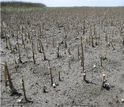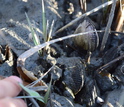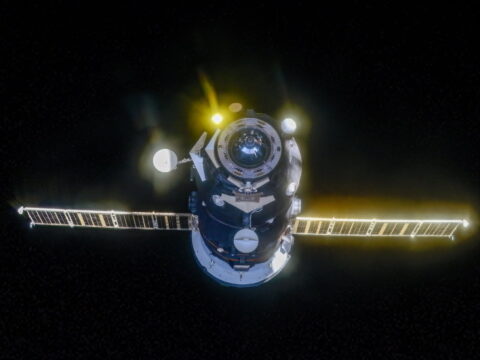
Research News
Relationship between mussels and marsh grass protects species, prevents grass die-off
August 19, 2016
Coastal ecosystems worldwide are feeling the heat of climate change. In the Southeastern U.S., salt marshes have endured massive grass die-offs as a result of intense drought, which can affect everything from fisheries to water quality.
Now, new research shows that a mutualistic relationship — where two organisms benefit from each other’s activities — between ribbed mussels and salt marsh grasses may play a critical role in helping salt marshes bounce back from extreme climate events such as drought.
The results, reported this week in the journal Nature Communications, found that mussels piled up in mounds around salt grass stems helped to protect the grasses by improving water storage around their roots and reducing soil salinity. With the mussels’ help, marshes can recover from drought in less than a decade. Without their help, it can take more than a century.
“This is a very good example of how the diversity of life in a salt marsh promotes resilience to climate and environmental change,” said David Garrison, program director in the National Science Foundation (NSF) Division of Ocean Sciences, which co-funded the research with NSF’s Division of Environmental Biology.
Marsh grass, mussels and mutual dependence
“It’s a story of mutual benefit between marsh grass and mussels,” said Christine Angelini, a scientist at the University of Florida and lead author of the paper.
The mussels, she said, “protect then accelerate the healing of drought-stricken marshes.”
Saving the marshes has environmental and economic benefits.
“Marsh die-off and loss can affect land value, fisheries and water quality,” Angelini said. “Even if just a little bit of vegetation survives, it makes a huge difference in how quickly the marsh comes back.”
Angelini and the paper’s co-authors became interested in the topic when three severe droughts in the Southeast over the past 17 years caused a major die-off of cordgrass, the region’s dominant, marsh-structuring plant.
Using Google Earth, the team selected nine sites that contained relatively large marsh areas likely to experience drought-associated grass die-offs. The sites, which were chosen at the end of a severe, two-year drought in June 2012, spanned 150 miles of coastline from southern Georgia to central South Carolina.
The marine biologists found that wherever there were clusters of mussels embedded in the mud around the base of the grass stems, the grass survived. In fact, grass growing in mussel clusters had a 64 percent probability of surviving, compared to a one percent probability in areas without mussels.
The researchers suspected that mussels, by paving the marsh surface with their ribbed shells, attracted burrowing crabs that excavate underground water storage compartments.
Backyard study site
One marsh study site was in the backyard of Dale Aren.
Sixteen years ago, Aren and her family bought property on Coburg Creek in Charleston, South Carolina. The scenery, which included a large marsh area, played a major role in their decision to buy the land.
Aren noticed, however, that the marsh behind her home was dying.
“We were worried,” she said. “The Spartina [grass] is beautiful but the increasing area of mudflats did not look healthy.”
Eventually Aren found a paper that described the problem. Brian Silliman, the University of Florida biologist who wrote the paper, is also a co-author of the current Nature Communications paper.
On the Aren property, researchers noticed that, in spite of the grass die-off, little patches of grass remained in the mudflats, mostly where there were mussels. They found that once the drought subsided, these dispersed grass patches expanded rapidly, healing the mudflats from the inside out.
Three years later, the mudflats on Aren’s property have largely recovered and reverted back to healthy marsh.
Mussel transplants?
According to Angelini, the next step is figuring out whether transplanting mussels into drought-vulnerable marshes could offer a low-cost solution to improve marshes’ resilience.
The scientists are also testing whether other at-risk ecosystems — such as seagrass meadows and coral reefs — may be similarly protected by mutualistic relationships between keystone species.
Other institutions involved in the research include Swansea University in the United Kingdom; the University of Groningen and Radboud University in the Netherlands; the Royal Netherlands Institute for Sea Research; and Duke University.
—
Cheryl Dybas,
NSF
(703) 292-7734 cdybas@nsf.gov
—
Steve Orlando,
University of Florida
(352) 846-3903 sfo@ufl.edu
-
Dead stalks of salt marsh grasses in a Sapelo Island marsh; the grasses died in a 2011-2012 drought.
Credit and Larger Version -
Ribbed mussels help maintain salt marsh grasses during a 2012 drought in Charleston, South Carolina.
Credit and Larger Version -
A mound of ribbed mussels is embedded in the mud around healthy salt marsh grass stems.
Credit and Larger Version -
Mussels pave the surface around salt marsh grass stems in a Georgia marsh.
Credit and Larger Version -
Marsh grasses killed by soil salinity stress in a Sapelo Island salt marsh in July 2016.
Credit and Larger Version
Investigators
Brian Silliman
Christine Angelini
Related Institutions/Organizations
Duke University
University of Florida
Related Awards
#1546638 EAGER: Secondary foundation species as drivers of ecosystem resilience
#1445834 CAREER: Small Grazers, Multiple Stressors and the Proliferation of Fungal Disease in Marine Plant Ecosystems
Total Grants
$491,722
Related Websites
Grass-planting change boosts coastal wetland restoration success: https://www.nsf.gov/discoveries/disc_summ.jsp?cntn_id=136663
Source: NSF News
Brought to you by China News













